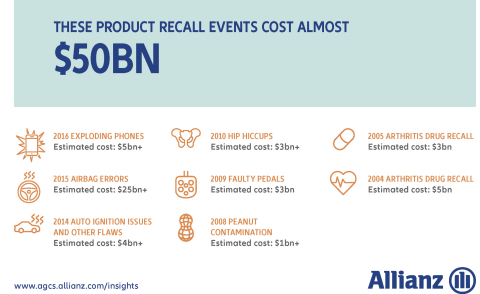Allianz Warns Product Recall Risks Grow as Technology Drives New Triggers

Claims Journal, December 2017
Defective product risk is an increasing peril for companies, causing significant financial damage, according to a newly released Allianz Global Corporate & Specialty (AGCS) report.
Recall exposures have increased significantly over the past decade, bringing the potential for larger and more complex losses than ever before, AGCS warned.
Product Recall: Managing The Impact of the New Risk Landscape analyzes 367 insurance industry product recall claims from 28 countries across 12 industry sectors between 2012 and the first half of 2017. Overall defective product or work is the major cause of recall claims, followed by product contamination. The average cost of a significant incident is in excess of $12 million, with the costs from the largest events far exceeding this total. Over 50 percent of losses arise from 10 incidents. The IT/electronics sector is the third most affected industry after automotive and food and beverage, according to the claims analysis.
“Product recalls have risen steadily in the past decade. We are seeing record levels of recall activity in size and cost today,” says Christof Bentele, head of Global Crisis Management at AGCS. “Tougher regulation and harsher penalties, the rise of large multi-national corporations and complex global supply chains, growing consumer awareness, impact of economic pressures in research and development (R&D) as well as production and even growth of social media are just some of the contributing factors behind this.”
Defective products not only pose a serious safety risk to the public but can also cause significant financial damage to the companies responsible. Defective product/work-related incidents have caused insured losses in excess of $2 billion over the past five years, making them the largest generator of liability losses, according to analysis2 of insurance industry claims by AGCS. Recall claims are a major contributor to this total, alongside product liability claims.
Automotive recalls most expensive and large-scale due to “ripple effect”

op Product Recall Events (Graphic: Business Wire)
Automotive recalls account for over 70 percent of the value of all losses analyzed, which is unsurprising given recent record levels of activity in both the US and Europe. “We see an increasing number of recalls with higher units in the automotive industry,” says Carsten Krieglstein, Regional Head of Liability, Central & Eastern Europe, AGCS. “This is driven by factors such as more complex engineering, reduced product testing times, outsourcing of R&D and increasing cost pressures. The technological shift in the automotive industry towards electric and autonomous mobility will create further recall risks.”
One of the largest recalls to hit the auto industry to date, involving defective airbags, is expected to result in some 60 to 70 million units across at least 19 manufacturers being recalled worldwide. Costs have been estimated at close to $25 billion.
Food and beverage is the second most impacted sector, accounting for 16 percent of analyzed losses with the average cost of a significant product recall claim almost $9.5 million. Undeclared allergens (including mislabeling incidents) and pathogens are a major issue, as is contamination from glass, plastic and metal parts. Malicious tampering and even extortion incidents pose an increasing threat, as well as the growth of “food fraud,” which has become a major issue, resulting in reputational damage and major losses.
Technology to prevent and drive future recall risks
The report also identifies emerging recall triggers that will drive future risks and claims, largely stemming from new technologies. Advances in product testing such as genome-sequencing technology will make it easier for regulators and manufacturers to trace contaminated products in future, potentially saving lives, but also potentially spiking litigation activity, as liable parties can be more easily identified.
Cyber recalls may become an increasing reality. Hackers could change or contaminate a product by controlling machinery in automated production plants. “Cyber is currently an underestimated risk,” says Bentele. “We have already seen recalls due to cyber security vulnerabilities in cars and cameras.” Innovative but untested technologies such as artificial intelligence and nanotechnology could also transform recall risk.
Pre-event crisis management as part of corporate DNA
Pre-event planning and preparation can have a big impact on the size of a recall and the financial and reputational damage sustained. As part of a holistic risk management program, specialized product recall insurance can help businesses recover faster by covering the costs of a recall, including business interruption. It also provides access to crisis management services, and consultants, which can test a company’s procedures and offer global support in areas such as regulatory liaison, communications, product traceability and tampering investigations as well as genome sequencing and DNA testing to understand a product contamination.
Categories
- Benefits Resources
- Bonding
- BOP
- Business Insurance
- Commercial Auto
- Commercial Property
- Company News
- Construction
- Crime Insurance
- Cyber Insurance
- Directors & Officers
- Employee Benefits
- Employment Practice Liability Insurance
- Entertainment
- General Liability
- Health Insurance
- Healthcare
- Healthcare Reform
- Homeowners Insurance
- Hospitality
- Manufacturing
- Medical Malpractice
- Mining & Energy
- Nightclubs
- Personal Auto
- Personal Insurance
- Professional
- Restaurants
- Retail & Wholesale
- Risk Management Resources
- Safety Topics
- SBA Bonds
- Security
- Seminars
- Technology
- Tourism
- Transportation
- Uncategorized
- Workers Compensation
Archives
- May 2021
- November 2020
- October 2020
- September 2020
- August 2020
- July 2020
- June 2020
- May 2020
- November 2018
- September 2018
- August 2018
- May 2018
- April 2018
- March 2018
- February 2018
- January 2018
- December 2017
- November 2017
- October 2017
- September 2017
- August 2017
- July 2017
- June 2017
- May 2017
- April 2017
- March 2017
- February 2017
- January 2017
- October 2016
- September 2016
- August 2016
- July 2016
- June 2016
- May 2016
- April 2016
- March 2016
- February 2016
- January 2016
- December 2015
- November 2015
- October 2015
- September 2015
- August 2015
- July 2015
- June 2015
- May 2015
- April 2015
- March 2015
- February 2015
- January 2015
- December 2014
- November 2014
- October 2014
- September 2014
- August 2014
- July 2014
- June 2014
- May 2014
- April 2014
- March 2014
- February 2014
- January 2014
- December 2013
- November 2013
- October 2013
- September 2013
- August 2013
- July 2013
- June 2013
- February 2013
- November 2011
- October 2011
- September 2011
- July 2011
- June 2011
- March 2011
- November 2010
- October 2010
- September 2010
- April 2010
- February 2010
- November 2009
- October 2009
- November 2008
- August 2008


